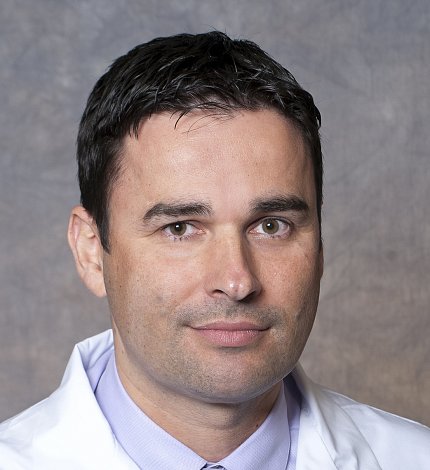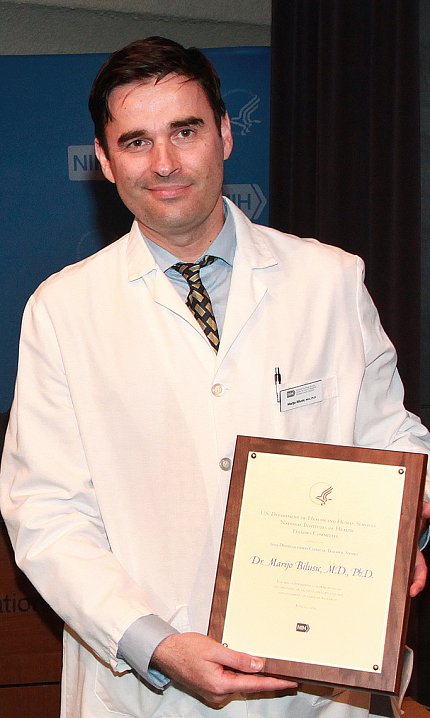How Much Farther?
Bilusic Navigates Journey to Personalized Medicine

The road to personalized medicine—therapies tailor-made for individual patients—has both hills and valleys, speedways and traffic jams, depending on which disorder is traveling.
At a recent Clinical Center Grand Rounds presentation, Dr. Marijo Bilusic, NCI associate research physician-turned-GPS navigator, offered a question, “Personalized Oncology: Are We There Yet?” He delivered the 16th annual John Laws Decker Memorial Lecture, a component of the Contemporary Clinical Medicine Great Teachers Series that honors the late CC director.
A physician-scientist in the Genitourinary Malignancies Branch of the Center for Cancer Research, Bilusic focuses on prostate tumors and immunotherapy. He’s also director of NIH’s Hematology-Oncology Fellowship and winner of 2019’s Distinguished Clinical Teacher Award.
Bilusic began his lecture by drawing a distinction: Personalized medicine, he said, means all aspects of care are customized, based on an individual patient. Precision medicine, in contrast, “aims to hit a target in the same place across different patients.” In oncology, for example, “tumors that share the same genetic change receive the treatment that targets the change, regardless of the cancer.”
Bilusic described the evolution of precision treatment that started with one-medicine-fits-all. Twenty years ago, for instance, everyone received cisplatin-based doublet for adjuvant therapy of lung cancer, he explained.
“As we go, we learn more over the years,” he said, “about the oncology, about tumor subtypes, demographics, biomarkers and clinical features…we started practicing stratified medicine. That’s today what we do.” If someone has hormone positive-breast cancer, for example, she’ll get adjuvant hormone therapy.
Oncology treatment then takes it a step further, he said, “once we know more, once we know exactly what’s driving the mutation and we have available tools and medications we can use. Then we can talk about precision medicine.”
Bilusic recalled that his own pursuit of personalized medicine began not with his current field of cancer but with hypertension.
After grad school, when trying to decide what specific career path to travel next, Bilusic came across the Guyton-Coleman model of blood pressure homeostasis.
“This model was published in 1972 and was heavily criticized at that time as being very simplistic,” Bilusic said.
But 30-some years later—around 2002 or so—looking at the work in the same climate as the then-newly released draft Human Genome Project, he said he “found [the BP model] very exciting and I was thinking that it should be a perfect example of personalized medicine. Now we have a genome sequence. We have detected multiple genes. This is a polygenetic disorder. Maybe by studying this, by dissecting the genetics of hypertension, we can provide more personalized treatment for blood pressure.”
In 2002, Bilusic moved from his home in Croatia to the Medical College of Wisconsin, where he worked on the Family Blood Pressure Program, part of an NHLBI-funded Multi-Center Genetic Study of Hypertension that phenotyped and genotyped about 11,000 people in the U.S.
Nearly a generation later, in 2020, hypertension treatment is pretty much standardized across age, sex and racial and ethnic groups. Development of individualized therapies for the disorder appear to be moving at a crawl, Bilusic observed.

“All of us would agree that personalized oncology and precision oncology are much more advanced than precision medicine in hypertension,” he said. “Why is progress so slow in one of the most commonly reported diseases such as hypertension?”
Bilusic suggested the answer may be one of economics. He pointed to a slide showing that cancer drugs—both prescription and over-the-counter—bring in the most pharmaceutical revenue, therefore there is a huge interest (and investment) by the industry in studying new oncology drugs. Average annual costs for oncology meds continue to trend upward, he said.
In 2018, a median yearly cancer treatment cost about $150,000. In addition, the FDA “breakthrough” designation—which expedites the approval process for highly promising therapies—in 2017 went to 2 percent of cardiology drugs versus 50 percent of cancer drugs.
“Currently we have about 850 molecules in late-phase development for oncology and it’s definitely moving toward targeted therapy and immunotherapy,” Bilusic said. “That’s why I think precision oncology is much more advanced than precision medicine in hypertension.”
He cited recent studies of advanced prostate and lung cancer to back up his argument that all patients with such metastatic tumors should be sequenced to identify possible genetic mutations for which successful treatments have already been proven.
Bilusic also talked about “exceptional responders,” or outlier patients who exceed expectations. “Most statisticians don’t like outliers,” he quipped. “Outliers can really mess up analysis. We oncologists really like them a lot. They are the patients we remember. They are our success stories and we love to share them with other patients and with our colleagues.”
In 2014, as an assistant professor at Fox Chase Cancer Center, Bilusic and colleagues wondered whether exceptional responders could help move precision oncology forward. The group studied 26 multi-year survivors who had battled one of several metastatic tumors including bladder, kidney, breast, lung, uterine and colon cancers.
“What was most striking was we found very high frequency of mutations in DNA damage response pathways, which suggests increased genomic instability in outliers,” Bilusic reported. So many outliers matched identical mutations across different tumor types.
Summing up, he predicted that one key advance for cancer precision medicine will be early detection via liquid biopsy, or sequencing of cell-free DNA (cfDNA). Perfecting liquid biopsy technology will propel precision oncology forward significantly because it also can detect cancer and recurrences 6 to 9 months sooner than imaging does.
“This still remains a challenge today because there is very low amount cfDNA found in patient blood,” Bilusic said.
“Precision oncology is running forward at a very fast pace,” he concluded. “Over the last 10 years, the overall cancer death rate has continued to decline and anti-cancer therapy has changed dramatically, particularly with development of immunotherapy and precision oncology. Despite all these accomplishments, clinical adoption of precision oncology has been very slow. As many as 60 percent of advanced-cancer patients are not receiving any form of genomic testing as of 2019.”
Why the slowdown? Bilusic suggested several theories: Oncologists’ lack of expertise with genomic data interpretation, costs of genomic sequencing remaining too high for many patients whose health insurance may not cover the process, and similarly, lack of insurance coverage of sequencing-derived drugs, which generally are expensive and not affordable when prescribed “off label.”
In terms of opportunities to move precision oncology into the fast lane, Bilusic recommended designing more innovative trials that enroll patients with different tumor types, but the same mutations, and pursuing further studies that involve outliers.
He also sees promise in developing personalized immunotherapy and vaccines; in exploring pharmacogenomics, which is in its early stages; and in artificial intelligence or machine learning—devising algorithms that could predict the best treatment sequence for a patient based on comparison with data found in historical patient profiles.
“Precision oncology is still growing,” Bilusic closed. “I don’t think we are there yet, but we are making dramatic progress every year. The future is very bright.”
